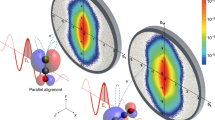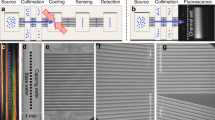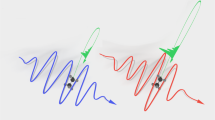Abstract
Trapping and laser cooling in atomic physics enables control of single particles and their dynamics at the quantum level in a background-free environment. Ultrashort intense laser pulses reveal the ultimate control of electromagnetic fields, enabling the imaging of matter, in principle down to a single molecule or virus resolved on atomic scales. However, current methods fall short in overlapping each target with a pulse of comparable size. We combine the two fields by demonstrating a deterministic molecular conveyor, formed of electric trapping potentials. We deliver individual diatomic ions at millikelvin temperatures and with submicrometre positioning into few-femtosecond ultraviolet laser pulses. We initiate and probe the molecule’s femtosecond dynamics and detect it and its response with 100% efficiency. This experiment might become key for investigations of individual molecules, such as structural determinations using few-femtosecond X-ray lasers. Our scheme may overlap each single molecule with a pulse, focused to (sub)micrometre size, providing the required number of photons at the repetition rate of the laser.
This is a preview of subscription content, access via your institution
Access options
Subscribe to this journal
Receive 12 print issues and online access
$209.00 per year
only $17.42 per issue
Buy this article
- Purchase on Springer Link
- Instant access to full article PDF
Prices may be subject to local taxes which are calculated during checkout




Similar content being viewed by others
References
Webster, G. & Hilgenfeld, R. Perspectives on single molecule diffraction using the X-ray free electron laser. Single Mol. 3, 63–68 (2002).
Henderson, R. The potential and limitations of neutrons, electrons and X-rays for atomic resolution microscopy of unstained biological molecules. Q. Rev. Biophys. 28, 171–193 (1995).
Neutze, R., Wouts, R., van der Spoel, D., Weckert, E. & Hajdu, J. Potential for biomolecular imaging with femtosecond X-ray pulses. Nature 406, 752–757 (2000).
Chapman, H. N. et al. Femtosecond time-delay X-ray holography. Nature 448, 676–679 (2007).
Young, L. et al. Femtosecond electronic response of atoms to ultra-intense X-rays. Nature 466, 56–61 (2010).
Seibert, M. M. et al. Single mimivirus particles intercepted and imaged with an X-ray laser. Nature 470, 78–81 (2011).
Chapman, H. N. et al. Femtosecond X-ray protein nanocrystallography. Nature 470, 73–77 (2011).
Yamashita, M. & Fenn, J. B. Negative ion production with the electrospray ion source. J. Phys. Chem. 88, 4671–4675 (1984).
Marklund, E. G., Larsson, D. S. D., Spoel, D. v. d., Patriksson, A. & Caleman, C. Structural stability of electrosprayed proteins: temperature and hydration effects. Phys. Chem. Chem. Phys. 11, 8069–8078 (2009).
Chou, C. W., Hume, D. B., Rosenband, T. & Wineland, D. J. Optical clocks and relativity. Science 329, 1630–1633 (2010).
Home, J. P. et al. Complete methods set for scalable ion trap quantum information processing. Science 325, 1227–1230 (2009).
Barrett, M. D. et al. Deterministic quantum teleportation of atomic qubits. Nature 429, 737–739 (2004).
Molhave, K. & Drewsen, M. Formation of translationally cold MgH+ and MgD+ molecules in an ion trap. Phys. Rev. A 62, 011401 (2000).
Offenberg, D., Zhang, C. B., Wellers, C., Roth, B. & Schiller, S. Translational cooling and storage of protonated proteins in an ion trap at subkelvin temperatures. Phys. Rev. A 78, 061401 (2008).
Birkl, G., Kassner, S. & Walther, H. Multiple-shell structures of laser-cooled Mg ions in a quadrupole storage ring. Nature 357, 310–313 (1992).
Friedenauer, A. et al. High power all solid state laser system near 280 nm. Appl. Phys. B 84, 371–373 (2006).
Schiller, S. & Lämmerzahl, C. Molecular dynamics simulation of sympathetic crystallization of molecular ions. Phys. Rev. A 68, 053406 (2003).
Gerlich, D. & Borodi, G. Buffer gas cooling of polyatomic ions in RF multi-electrode traps. Faraday Discuss. 142, 57–72 (2009).
Smith, I. W. M. Low Temperatures And Cold Molecules (Imperial College Press, 2008).
Paul, W. Electromagnetic traps for charged and neutral particles. Rev. Mod. Phys. 62, 531–540 (1990).
Kjægaard, N., Hornekær, L., Thommesen, A., Videsen, Z. & Drewsen, M. Isotope selective loading of an ion trap using resonance-enhanced two-photon ionization. Appl. Phys. B 71, 207–210 (2000).
Graf, U. et al. Intense few-cycle light pulses in the deep ultraviolet. Opt. Express 16, 18956–18963 (2008).
Jørgensen, S., Drewsen, M. & Kosloff, R. Intensity and wavelength control of a single molecule reaction: Simulation of photodissociation of cold-trapped MgH+. J. Chem. Phys. 123, 094302 (2005).
Brinks, D. e. a. Visualizing and controlling vibrational wave packets of single molecules. Nature 465, 905–908 (2010).
Hamm, P. et al. Femtosecond spectroscopy of the photoisomerisation of the protonated Schiff base of all-trans retinal. ChemPhysChem 263, 613–621 (1996).
Kuehner, D. E. et al. Lysozyme net charge and ion binding in concentrated aqueous electrolyte solutions. J. Phys. Chem. B 103, 1368–1374 (1999).
Schätz, T., Schramm, U. & Habs, D. Crystalline ion beams. Nature 412, 717–720 (2001).
Schramm, U., Schatz, T. & Habs, D. Three-dimensional crystalline ion beams. Phys. Rev. E 66, 036501 (2002).
Boutet, S. & Williams, G. J. The Coherent X-ray Imaging (CXI) instrument at the Linac Coherent Light Source (LCLS). New J. Phys. 12, 035024 (2010).
Leschhorn, G., Hasegawa, T. & Schaetz, T. Efficient photoionization for barium ion trapping using a dipole-allowed resonant two-photon transition. Preprint at http://arxiv.org/abs/1110.4040 (2011).
Schaetz, T. et al. Towards (scalable) quantum simulations in ion traps. J. Mod. Opt. 54, 2317–2325 (2007).
Barrett, M. D. et al. Sympathetic cooling of 9Be+ and 24Mg+ for quantum logic. Phys. Rev. A 68, 042302 (2003).
Lee, K. F., Villeneuve, D. M., Corkum, P. B., Stolow, A. & Underwood, J. G. Field-free three-dimensional alignment of polyatomic molecules. Phys. Rev. Lett. 97, 173001 (2006).
Acknowledgements
Financial support is gratefully acknowledged by the Deutsche Forschungsgemeinschaft (DFG), the DFG Cluster of Excellence: Munich Centre for Advanced Photonics, the International Max Planck Research School on Advanced Photon Science and the EU research project PICC: the Physics of Ion Coulomb Crystals, funded under the European Communities Seventh Framework Programme. The authors would like to thank J. Britton, W. Schmid, C. Hackenberger, J. Bayerl, M. Schulze, T. Dou and C. Kerzl for their contributions and H. J. Neusser for support of a continuous-wave cooling laser. We also thank D. Habs for the triggering discussion and G. Rempe for his intellectual and financial support.
Author information
Authors and Affiliations
Contributions
S.K. and G.L. contributed equally to this work. M.K., W.F. and R.d.V-R. developed the theory. A.S., E.B., R.E., F.K., R.K. and T.S. contributed to the experimental work.
Corresponding author
Ethics declarations
Competing interests
The authors declare no competing financial interests.
Supplementary information
Supplementary Information
Supplementary Information (PDF 244 kb)
Rights and permissions
About this article
Cite this article
Kahra, S., Leschhorn, G., Kowalewski, M. et al. A molecular conveyor belt by controlled delivery of single molecules into ultrashort laser pulses. Nature Phys 8, 238–242 (2012). https://doi.org/10.1038/nphys2214
Received:
Accepted:
Published:
Issue Date:
DOI: https://doi.org/10.1038/nphys2214
This article is cited by
-
Mass-selective removal of ions from Paul traps using parametric excitation
Applied Physics B (2020)
-
High-energy multicolor femtosecond pulses in the deep-ultraviolet generated through four-wave mixing induced by three-color pulses
Applied Physics B (2016)
-
A far-off-resonance optical trap for a Ba+ ion
Nature Communications (2014)
-
Deterministic delivery of externally cold and precisely positioned single molecular ions
Applied Physics B (2012)



